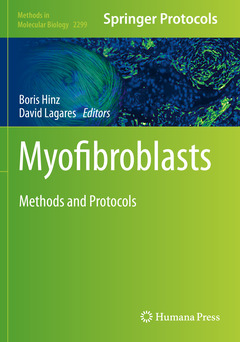Description
Myofibroblasts, 1st ed. 2021
Methods and Protocols
Methods in Molecular Biology Series, Vol. 2299
Coordinators: Hinz Boris, Lagares David
Language: English
Subjects for Myofibroblasts:
Publication date: 05-2021
460 p. · 17.8x25.4 cm · Paperback
Publication date: 05-2021
460 p. · 17.8x25.4 cm · Hardback
Description
/li>Contents
/li>Comment
/li>
1. 50 Years of Myofibroblasts: How the Myofibroblast Concept Evolved
Giulio Gabbiani
Section I: Fundamental Methods to Study Myofibroblast Biology
2. Myofibroblast Functions in Tissue Repair and Fibrosis: An Introduction
Victor J. Thannickal
3. Myofibroblast Markers and Microscopy Detection Methods in Cell Culture and Histology
Fereshteh Younesi, Dong Ok Son, Joao Firmino, and Boris Hinz
4. Fibroblast and Myofibroblast Subtypes: Single Cell Sequencing
Hesham Soliman, Lin Wei Tung, and Fabio M.V. Rossi
5. Myofibroblast Adhesome Analysis by Mass Spectrometry
Christopher A. McCulloch
6. Myofibroblast TGF-β Activation Measurement In Vitro
Joanne Porte, Gisli Jenkins, and Amanda L. Tatler
7. Contraction Measurements Using Three-Dimensional Fibrillar Collagen Gel Lattices
James Griffith and William L. Berry
8. Techniques to Assess Collagen Synthesis, Deposition, and Cross-Linking In Vitro
Tamara Rosell-García and Fernando Rodriguez-Pascual
9. Methods for Studying Myofibroblast Apoptotic Pathways
Yan Zhou and David Lagares
10. Determination of Senescent Myofibroblasts in Precision-Cut Lung Slices
Tamara Cruz, Ana L. Mora, and Mauricio Rojas
11. The Scar-in-a-Jar: In Vitro Fibrosis Model for Anti-Fibrotic Drug Testing
Simon Stebler and Michael Raghunath
Section II: Myofibroblast Mechanobiology
12. Why Stress Matters: An Introduction
Daniel J. Tschumperlin
13. Soft Substrate Culture to Mechanically Control Cardiac Myofibroblast Activation
Natalie M. Landry, Sunil G. Rattan, and Ian M.C. Dixon
14. Quantitative Analysis of Myofibroblast Contraction by Traction Force Microscopy
Shuying Yang, Fernando R. Valencia, Benedikt Sabass, and Sergey V. Plotnikov
15. Nucleocytoplasmic Shuttling of the Mechanosensitive Transcription Factors MRTF and YAP/TAZ
Michael Kofler and András Kapus
16. Atomic Force Microscopy for Live-Cell and Hydrogel Measurement
Alexander Whitehead, Natalie J. Kirkland, and Adam J. Engler
17. Method for Investigating Fibroblast Durotaxis
Hossam Kadry, David Lagares, and Taslim A. Al-Hilal
18. Decellularized Extracellular Matrix (ECM) as a Model to Study Fibrotic ECM Mechanobiology
Chiuan-Ren Yeh, Grace C. Bingham, Jagathpala Shetty, Ping Hu, and Thomas H. Barker
19. Fibrosis on a Chip for Screening of Anti-Fibrosis Drugs
Mohammadnabi Asmani and Ruogang Zhao
Section III: Animal and Human Models to Study Myofibroblast Biology
20. Animal and Human Models of Tissue Repair and Fibrosis: An Introduction
David Lagares and Boris Hinz
21. Mouse Models of Lung Fibrosis
Olivia Mekhael, Safaa Naiel, Megan Vierhout, Aaron Hayat, Spencer Revill, Soumeya Abed, Mark Inman, Martin Kolb, and Kjetil Ask
22. Mouse Models of Kidney Fibrosis
Rafael Kramann and Sylvia Menzel
23. Mouse Models of Liver Fibrosis
Aashreya Ravichandra and Robert F. Schwabe
24. Mouse Models of Muscle Fibrosis
Antonio L. Serrano and Pura Muñoz-Cánoves
25. Mouse Models of Skin Fibrosis
Aleix Rius Rigau, Markus Luber, and Jörg H.W. Distler
26. Mouse Models of Intestinal Fibrosis
Jiannan Li, Dina Dejanovic, Megan T. Zangara, Jyotsna Chandra, Christine McDonald, and Florian Rieder
27. A Rodent Model of Hypertrophic Scarring: Splinting of Rat Wounds
Dong Ok Son and Boris Hinz
28. Three-Dimensional Model of Hypertrophic Scar Using a Tissue-Engineering Approach
Veronique J. Moulin
29. Methods for the Study of Renal Fibrosis in Human Pluripotent Stem Cell-Derived Kidney Organoids
Alejandro Moran-Horowich and Dario R. Lemos
30. Decellularized Human Lung Scaffolds as Complex Three-Dimensional Tissue Culture Models to Study Functional Behavior of Fibroblasts
Gerald Burgstaller, Michael Gerckens, Oliver Eickelberg, and Melanie Königshoff
Includes cutting-edge techniques
Provides step-by-step detail essential for reproducible results
Contains key implementation advice from the experts




